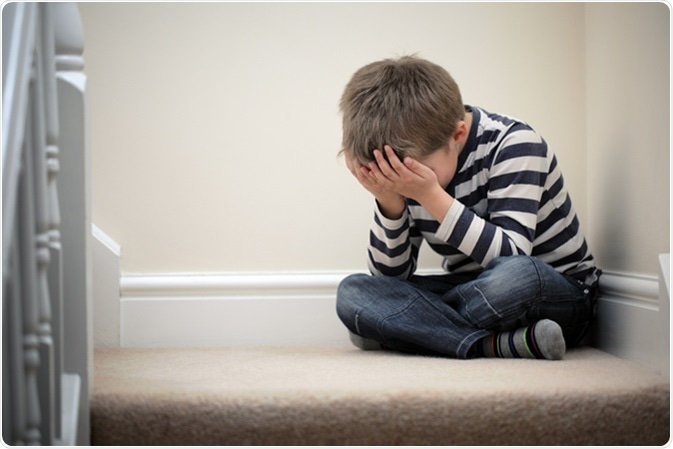
How to Ease Anxiety in Children
Anxiety in children has several roots, such as family disagreements, and separation from parents and regular care-givers.
Fears are common in children, but the presence of such feelings is not indicative of an anxiety disorder. Such disorders are, however, the most common form of mental disorder in children. They are manifested by extreme fearfulness, sadness or depression.
Anxiety is called an internalizing disorder, because it involves the child’s thoughts and emotional states. It can result in a negative perception of life, causing distress and an inability to live normally.

Image Credit: Brian A Jackson / Shutterstock
Causes of Childhood Anxiety
A genetic or environmental contribution cannot be ruled out, because the incidence of childhood anxiety is higher in the offspring of anxious parents.
This could be due to the style of parenting, the type of communication between parents and children, or individual variation in the way one perceives and handles stress or danger.
An excessively protective or dominating parent may negatively impact the manner in which the child learns to face challenging situations.
Treatment
There is effective treatment in the form of medication, psychological counselling, and cognitive behavioral therapy.
The difficulty is that many children with anxiety are not taken seriously in contrast with those suffering from other conditions like depression.
Many healthcare providers fail to understand that childhood and adolescent anxiety is a cause of great suffering and may persist well into adolescence and adulthood.
It may affect the way children perceive relationships with others, and the formation of such bonds. It may inhibit social interactions and limit academic or job opportunities. It may prevent the development of warm or supportive friendships.
For these reasons, childhood anxiety disorders must be properly diagnosed and dealt with to optimize the child’s mental health and emotional development.
The first step is to evaluate the child’s background in terms of relationships at home, school and within the neighborhood and other social settings. Biological, emotional and developmental factors must also be taken into consideration.
Many modes of assessment may have to be used depending on the child’s age and ability to undergo formal testing.
Multiple sources of information must be utilized to obtain a better or more complete picture of the child’s emotional state and responses, including the current disorder or disability, as well as the appropriate areas to be targeted for treatment.
The treatment of choice for anxiety disorders in children remains cognitive behavioral therapy (CBT), because these recognize and treat the multiple facets of the child’s disorder.
These include physical illness or symptoms, thought patterns leading to exacerbation of the condition, and resulting faulty behaviors, such as clinginess, avoidance, and crying.
CBT has been shown to produce a beneficial result in 7 out of 10 anxious children, and can be extended to include the family, friends, and school groups.
Drug therapy has been studied extensively with reference to the selective serotonin reuptake inhibitors (SSRIs). SSRIs have been found effective with relation to separation anxiety, social anxiety, and generalized anxiety disorder.
Fluvoxamine is the drug most recommended, and tricyclic antidepressants are not found to be suitable as first-line treatment. Side-effects are to be expected and parents should be on the watch for them.
The type of therapy should be decided based on an individual case approach. Referral to professional counselors or psychiatrists should be promptly done if indicated.
In addition to the above, children with anxiety should have a healthy and adequate diet containing enough fruits and vegetables, plus whole grains, nuts, seeds, fish and lean protein.
Regular physical exercise is to be modeled and recommended by going out with the children to play, do yard chores, or just doing physical work around the house. Sleep times should be sensible, but realistic, allowing the child to have 9-10 hours of sleep every night.
Stress reduction techniques, including thankfulness and prayer can play a huge role in recovery, as can helping others.
Helping children prepare for social interactions is also a good booster during recovery by providing the necessary confidence and boldness to venture into company.
Prevention
While biological and temperamental factors may play a role in the genesis of anxiety in children, it is possible to foresee and forestall its development in many situations.
This may involve teaching children how to overcome moodiness and emotional swings, advocating for them in situations where they are overwhelmed by the fear of danger, and providing unconditional support and assurances of love by words and deeds.
Among many other suggestions, supporting the child’s family if it is going through difficult emotional times, such as the birth of a new child, especially if the first child is accustomed to getting a good deal of attention, is also found to be a preventative strategy.
References
- https://www.cdc.gov/childrensmentalhealth/depression.html
- https://www.nimh.nih.gov/health/topics/anxiety-disorders/index.shtml
- https://www.ncbi.nlm.nih.gov/pmc/articles/PMC1071700/
- https://www.gov.uk/government/uploads/system/uploads/attachment_data/file/508847/Mental_Health_and_Behaviour_-_advice_for_Schools_160316.pdf
- http://www.nhs.uk/conditions/anxiety-children/Pages/Introduction.aspx#types
Further Reading
Last Updated: Feb 26, 2019






















.png)










No hay comentarios:
Publicar un comentario